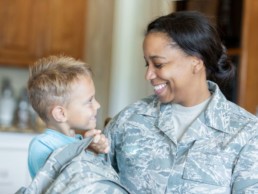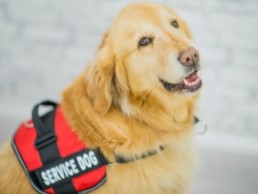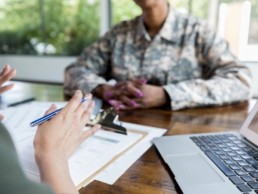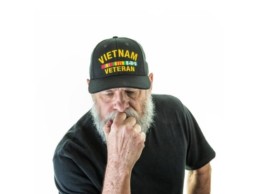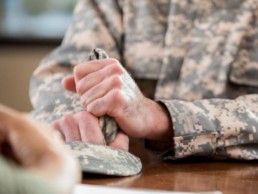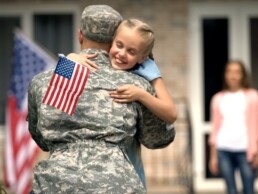Home Buying Advice For Veterans
Our nation’s veterans receive some specific financial benefits upon their discharge from the military. It's crucial they recognize and receive the advice needed to take full advantage of these offers. Veterans can receive benefits ranging from social security to home buying perks. Below are a few important tools and strategies veteran homebuyers can familiarize themselves with to make homeownership easier.
Utilize a VA Loan
When looking to purchase a home as a veteran, accessing Veteran Affairs (VA) loan is a great place to start the process. VA loans are filled with wonderful benefits that you can take advantage of. Purchasing a home with no down payment, lower credit score requirements to be eligible for a loan, and the access to lifetime benefits are just a few of the multiple great benefits you can receive from a VA Loan.
To qualify for a VA loan from a mortgage lender, you must be a veteran, an active duty service member, or a military spouse. But those are not the only eligibility requirements to determine if you will receive a VA loan or not.
If you’re hoping to acquire a loan, some other requirements include serving 90 consecutive days during wartime or 181 days during peacetime as an active duty service member, you have served in the National Guard or Reserves for six years, or you’re the spouse of a service member who suffered a service-related disability or has died in the line of duty.
There is more than one type of VA loan that you can choose from if you meet the eligibility requirements to qualify for one. Each different type of loan depends on certain criteria including credit score, income, and other factors. Bringing in a VA loan savvy real estate agent and completing a Certificate of Eligibility (COE) online are great ways to help you determine what loan type you should go for.
Get the Proper Paperwork in Order
There is plenty of information needed to get your VA loan process underway. The previously mentioned COE, form DD-214, and other general information will be needed during the loan acquisition process.
The COE is a document created by veteran affairs that provides information that proves that you are eligible for a VA loan. It is important to complete this certificate early on in your process as it will help move everything as long as smoothly as possible. A COE can be obtained through eBenefits online.
Form DD-214 is another required document you will need to obtain in the process of acquiring a VA loan if you are currently a military veteran. It shows proof of your discharge from the military. Acquiring your DD-214 form is a straightforward process that you can do yourself or have someone else do for you.
Other common documents needed during the process include a government-issued ID, your W-2 and tax returns from the previous two years, and most recent bank statements and pay stubs. Getting all of these documents together ahead of time will help reduce the stress of the process. To further reduce any financial anxieties and streamline your search, we suggest getting pre-approval on your mortgage. The sooner the paperwork and logistics are taken care of, the sooner you can begin your search for the perfect home.
Searching for Your Home
Once you create your budget, get your loan and mortgage approved, and have all your paperwork in order, you can finally begin the house-hunting process. It’s important to take care of all of the logistical aspects of the process before beginning to look at homes to ensure that you do not fall in love with any homes that you may prove to not be a realistic purchase for you later in the process.
You must consider things such as the school district if you have kids and any taxes that come along with the school district you are located in. Depending on what state you’re looking to live in, there are some different veteran housing benefits in each state. So make sure you familiarize yourself with any potential benefits the state you are looking to live in may offer to you.
Homebuying is a very exciting process, but could also be stressful. It’s important for veterans, active military members, and their families to be informed of the benefits they may be eligible for so they can utilize them to the fullest. Purchasing a home is a huge undertaking and accomplishment, and should be treated as such.
Many Veteran Women may be long overdue a Purple Heart Medal!
Women have only been active in the military for 70 years, but in each of those years they have joined in a significant amount, increasing every year. Compared to 1973, where enlistment of women soldiers was approximately 70,000, there are more than 200,000 women in active duty today serving in every branch of the U.S. military. Given the number of servicewomen, including having courage for being on the front lines and getting hurt, why do so few women actually receive their Purple Heart Medal? As you know, The Purple Heart is the only medal awarded to service members when they have greatly sacrificed themselves and have been injured in the line of duty. It has been known throughout history that men are usually the ones out fighting since the earliest wars. It is possible that the sheer number of men compared to women in the military today can still overshadow the many contributions that women have made. But that is unfair. With this in mind, we want to call attention to and highlight the disparities, share their stories, and acknowledge the contributions of our women vets. Based on the sheer quantity of women service members and no short supply of accomplishments and sacrifice, there should be more that have received the medal. All veterans deserve to be recognized for their sacrifices, especially from the physical, mental, and emotional scars that they will carry for the rest of their lives.
Women and the Purple Heart Medal
Women began to join the military in 1948, just three years after the end of World War II. President Harry S. Truman signed the Women’s Armed Services Integration Act into law, officially allowing women to serve as permanent members of all branches of the Armed Forces. Surprisingly, there have only been approximately 500 women that have been awarded the Purple Heart medal in the entire history of the military. There is no doubt that there are more women who are eligible for the award, but either they have not applied or have not been recognized. It is extremely important to recognize the sacrifice of their bodies and minds on the battlefield because each woman in active duty has given up some important qualities of their lives for our country, including time away from their families, losing physical abilities they once had, and losing their sanity . The medal is an example of the honor that the United States bestows upon them and all of our veterans deserve this respect.
Antoinette Scott’s Story
She was actually the first woman from Washington D.C. to have received the Purple Heart. She served eight years in the D.C Army National Guard and was deployed to Iraq in support of Operation Iraqi Freedom in 2003. She recalls the time her injuries happened during her mission driving a truck with soldiers to Baghdad Airport while being under attack. She managed to get the entire group to safety. She says, “There was so much going on, I didn’t have a chance to think about myself until I touched my face and I thought it was sweat and I saw blood. At that moment, I’m like, ‘Someone is bleeding,’ it wasn’t happening to me in my mind.” The truck was hit by an explosive device that led to shrapnel going through the left side of her face, breaking her jaw and a main blood vessel to her brain. She sustained life-threatening injuries, but the team she drove was able to evacuate her on time to save her life.
Marlene Rodriguez Story
She served three tours in Iraq before she had to retire and come back home. Marlene retired in 2009 due to experiencing two roadside bomb explosions and a firefight during her time in Iraq. She was diagnosed with traumatic brain injury (TBI) and Post-Traumatic Stress Disorder (PTSD), which left her disabled. She says, “I miss it so much. Just the structure, the discipline, the leadership,The honor.” As a result of her time in war, Marlene suffers from seizures, is unable to walk far due to back problems, and cannot express herself how she wants. Today, Marlene is frustrated with all the problems that will plague her for the rest of her life.
Conclusion
Antoinette and Marlene’s stories are just two stories of many in combat that still suffer from physical and mental injuries sustained in the battlefield. We salute and honor these two heroes, as well as countless others affected. What we are witnessing with these women is history in the making. Even today women can still become some of the first of 1,000 women to ever receive the medal, compared to more than 1 million men who have received it. These women throughout history have been soldiers, leaders and have sacrificed for the essential freedoms that we enjoy today. But unfortunately, most of them won’t receive a ticker tape parade, let alone the Purple Heart Medal. We want to encourage those who have not received the medal to apply if eligible. If you believe you know someone that does not have the medal and could be a candidate, recommend them to apply as it’s never too late to do so. Here is a website that shows the documents, resources, and examples of what needed to apply for the Purple Heart Medal.
Can We Talk About How Veteran Service Dogs Work Hard To Be More Than Just Man’s Best Friend?
Ever notice when you’re out at the gym, or the grocery store, or the train station,places you least expect to see an animal, you see a person walking with a dog? Well, your eyes aren’t deceiving you and these are not just any ordinary canines, they are actually incredibly trained service dogs. You likely won’t see the effects of what they do or how they help out their owner, but there is more to them than meets the eye. Service dogs assist veterans with different needs in a variety of ways and it is something that, as a veteran supporting community, we should talk about. They aren’t just there to keep company, but to help handlers with disabilities so that they can lead more independent lives.
The Best of the Best
Service dogs can help in the range of physical, sensory, psychiatric, intellectual, or even mental disabilities that a veteran can have. About 50% – 70% of dogs picked fail through service training. Dogs must be above average when it comes to their abilities, and this is only the very beginning of determining a worthy service dog. Service dogs in training must be able to exhibit a desire to work, a calm demeanor, high intelligence, and have a friendly and loving disposition. So, it takes more than a good nose to be a service dog.
Testimony
Veteran Toye Hickman is a service dog owner who shared her testimony about how her life has changed since she first got her service dog, as she deals with post-traumatic stress disorder, depression and anxiety. “He understands when my anxiety is going up. He’ll follow me around, he’ll pester me to get up and do something,” Hickman said. “If I’m having a down day, even though he’s a very active dog, he’ll lay right beside me and won’t leave my side.” Toye says her life changed when her service dog Bake entered it just two years ago.
Purple Heart Testimony / Clay the Service Dog
The Purple Heart Foundation believes that service dogs can truly help veterans, and that is why we offer this program to veterans. Watch retired veteran Jim Mirick, in his own words, detailing how much his service dog has helped him. He states, “He and I have such a bond together, he’s very tight with me, he’s irreplaceable to me.” Speaking of service dogs, our newest member to the Purple Heart Foundation family is Clay the service puppy, named after Purple Heart Recipient and former Purple Heart Foundation board member, Clayton Jones who passed in 2021. Clay is in the early stages of his nearly twenty four month training program, and from what we can tell he is determined and working hard through the process as a young student.
Conclusion
When the time comes, Clay will be matched with an honorably discharged veteran and their family, hopefully providing invaluable support while making a significant difference in a veterans’ life. Giving new meaning to the phrase Man’s best friend, our returning heroes, with their new companions, will be able to return towards the path of independence. Click here to learn more about our service dog program.
Did You Know About This Secret Handshake?
The Handoff
A secret handshake as you may know, typically belongs to secret clubs and organizations. Secret handshakes have developed over time, nowadays close friends, teachers and students, and athletes can be seen doing their own version of personal secret shake. These handshakes are a way to show that you are a part of a special or elite group, and that other people, well, are not. But there is one secret handshake that has been around a lot longer than your typical frat handshake, less ornate but with one very significant difference. Enter… the challenge coin.
Unless you are affiliated with the military or local law enforcement, you likely have never heard of this handshake. The reason you likely never heard of it is because of the way the coin is passed. A high ranking official walks up to a soldier and extends his hand to the soldier, they shake hands and just like that it's over! It's a quiet and discreet exchange, designed to not call attention. However, at that moment that soldier has just been honored for an important action they took in their field of duty or for their accomplishment of a mission. The unit commander just walks up and shakes their hand directly and places a small round object directly into their palm. But what does that mean?
What is a Challenge Coin?
Challenge coins are specially designed coins that are not necessarily meant to be traded. A challenge coin is a coin given to a member of a group to commemorate a moment in time. These coins are in remembrance of your time in the military. They are also used to reward or honor someone when they have achieved something remarkable. The challenge coin is of high personal value, and indeed it is a priceless thing to own. They are collectibles in which people are proud to show off in their offices or at home and each challenge coin houses a story for the person who possesses it.
Although you can find challenge coins primarily throughout military culture, that doesn’t mean you can’t find them anywhere else. Many organizations such as firefighters, local law enforcement, and even nonprofits utilize challenge coins as nod to the original uses. The Purple Heart Foundation has its own challenge coin usually given to the strongest supporters of its veteran services programs, we’ll talk about that at another time in another blog.
The tradition of challenge coins has been around for decades and even comes with its own set of rules. Stay tuned for the next blog where we dive deeper into the legacy of the challenge coin.
Mesothelioma in Veterans: 4 Things to Know
Veterans today are at risk for developing a multitude of illnesses that can range in impact from mild to extreme. Whether it be a physical injury from one incident, or delayed onset symptoms as a result of prolonged exposure to certain hazards, the life of a veteran can be in danger long after they are no longer actively serving. One serious illness that veterans can be at risk of developing is mesothelioma. Here are some things that all veterans should know about this dangerous cancer:
1. Veterans make up 30% of those diagnosed with mesothelioma in the United States.
Mesothelioma is a rare form of cancer caused by the inhalation or ingestion of asbestos fibers. Asbestos is a mineral that can be found in various construction materials, especially in products used prior to the 1970s. Due to its average 10-50 year latency period, mesothelioma does not usually present itself until much later that the asbestos exposure occurs.
While all veterans and active duty service members are at risk for having been exposed to asbestos, you are more likely to have been exposed and develop mesothelioma if you served between the years 1930 and 1980. This is due to the high volume of asbestos products being used and the low restrictions of their use.
There is an even higher correlation between mesothelioma and navy veterans. Asbestos-containing materials are especially common in shipyards and shipbuilding materials, and being in tight spaces can increase the risk of asbestos fiber inhalation. Veterans who served in this branch should be high-alert for mesothelioma symptoms.
2. Mesothelioma can affect more than the lungs.
Mesothelioma is often thought of as only being a type of lung cancer. However, this disease has various types that can impact different parts of the body. Each type of this cancer also comes with a different set of symptoms. The most common form of mesothelioma is pleural mesothelioma, which affects the lining surrounding the lungs. This type of mesothelioma is responsible for about 80-90% of diagnosed cases. Symptoms of pleural mesothelioma might include chest pain, a persistent cough, coughing up blood, shortness of breath, fever, and night sweats.
The next most common form of this cancer is peritoneal, which affects the lining that surrounds your abdominal organs. Peritoneal mesothelioma can include symptoms like abdominal pain and swelling, weight loss, and even blood clotting.
The two other, more rare, types of mesothelioma are pericardial and testicular. Pericardial mesothelioma affects the lining surrounding the heart, and testicular mesothelioma affects the lining around the testicles. Symptoms of mesothelioma in your heart include chest pain and an irregular heartbeat. And for testicular mesothelioma,you might experience testicular pain, scrotal swelling, and you might even notice a mass.
3. Asbestos exposure is possible even after active duty.
While exposure to asbestos might be more likely to occur during active duty, veterans can also be at risk for exposure depending on their career path after serving. Because of skill sets gained from your time in the military, many veterans may choose to follow careers in engineering, construction, or mechanics. These occupations are all at risk for asbestos exposure due to the products used.
You may also be at risk after your years of active service from secondhand asbestos exposure. Secondhand exposure can occur when there are asbestos fibers left on your uniforms or personal belongings, and you end up inhaling or ingesting them. You could also come into contact with someone who is still serving and in the presence of asbestos-containing materials, which could put you at risk.
4. You have resources to help.
If you have suspected symptoms of mesothelioma, it is crucial to visit a doctor. Early diagnosis can be critical in the setup and success of mesothelioma treatment. However, both the treatment for mesothelioma and the illness itself can greatly impact your financial situation and your ability to provide for yourself and your family. Luckily, organizations have recognized this and have implemented ways to help.
The U.S. Department of Veteran Affairs (VA) recognizes illnesses due to asbestos exposure during service and has made financial benefits available for things like expensive treatments and potentially lost wages. Veterans can file a mesothelioma VA claim, or an asbestos-related lung cancer claim, both of which are given a 100% disability rating. The VA can also assist with finding specialized care through VA accredited hospitals.
Life after active duty can be a difficult period of adjustment and you may still feel the impacts of your time in the service for years to come. You can set yourself up for life-long success by arming yourself with as much information as possible and the knowledge that you have help available to you.
4 Ways Veterans Can Take Control Of Their Finances
Taking control of your finances can be trying for anyone, but for struggling veterans, this issue may feel impossible to tackle. Luckily, there are lots of resources available, and the Purple Heart Foundation prides itself on helping military veterans and recognizing the sacrifices they’ve made. We would like to extend some information on how veterans can take control of their own finances on an individual basis.
1. Check Your Credit Score
Credit scores may not be the first thing on your mind when checking your bank accounts, but they are an extremely important tool that is needed when making big-ticket purchases. For example, buying a home will require a credit score check before you are able to take out a loan. Although VA loans offer flexibility to veterans, it’s still a great idea to first understand what credit score is needed to buy a home. Checking your credit score is free and won’t impact your credit. Plus, just this small step will allow you to gain a clearer picture of your financial situation.
2. Have a Plan to Pay Off Your Debts
Anyone struggling with debt understands the burden it can have. However, it’s crucial that big and small debts alike come with a plan for paying them off. Some of the more important factors to consider when creating a debt payoff plan that financial experts recommend is to include what your baseline budget will be and how much you’re going to allocate each month toward your debt payoff. Having an idea of how you’re going to pay your debts on time and eventually living debt free will be a huge weight off your shoulders and allow you more flexibility in your finances.
3. Cancel Unnecessary Subscriptions and Limit Overspending
Overspending is a common problem for many. There’s a reason such a thing as “retail therapy” exists! But that joy from buying a fancy back scratcher will quickly fade once you do the math on how much these unnecessary wants are costing you. Ways to combat emotional spending may include window shopping instead of buying so you can learn to understand what triggers your desire to overspend. Even taking a look at your monthly subscriptions, such as streaming services, and cutting back on those can help you increase your budget and improve your ability to meet long-term financial goals.
4. Save Up Toward Retirement
Lastly, retirement should be a huge consideration and part of your overall financial plan. Whether it’s through a 401(k) plan or savings account, having money set aside specifically for your retirement is a great way to start. Consider also speaking with a financial advisor to see exactly how much you and your family should save up to retire, and what your individual options are.
Taking control of your finances is no small task, and with the COVID-19 pandemic, this task may become that much more difficult. The Purple Heart Foundation is committed to helping veterans in whatever way possible, so we hope these steps will help you take control of your finances. If you would like to help veterans who are struggling financially, please be sure to check out our Veterans Critical Assistance Grant and make a donation today. Together, we can make a difference in the lives of our nation’s veterans.
Guardians of Democracy
The Purple Heart Foundation prides itself in recognizing military service members throughout the years. The United States military, law enforcement and first responders are an essential part of this country as they give their lives for our freedom and our safety. This past year has been very tough for everyone due to COVID-19, but it has been especially hard on our essential workers. The Purple Heart Foundation would like to extend a heart-warming thank you to these guardians for protecting our freedom and ensuring our safety. During this Black History Month, we recognize Eugene Goodman for his heroic efforts on Jan 6, 2020 during the attack on the capital building.
Eugene Goodman was born and raised in the Southside of Washington D.C. in the 1980’s. Goodman had humble upbringings and graduated from Central High School in Capitol Heights in 1999. Many of his teachers have come out expressing how truly proud they are of him. They described him as a quiet, helpful, and well-mannered student. It is said that, without even knowing it, he took on the role of peacekeeper at a young age by breaking up fights in the lunchroom on occasion. “To save this country, I mean for this person to save this country, I just feel so connected,” one of his teachers, Mr. Banks, expressed through tears.
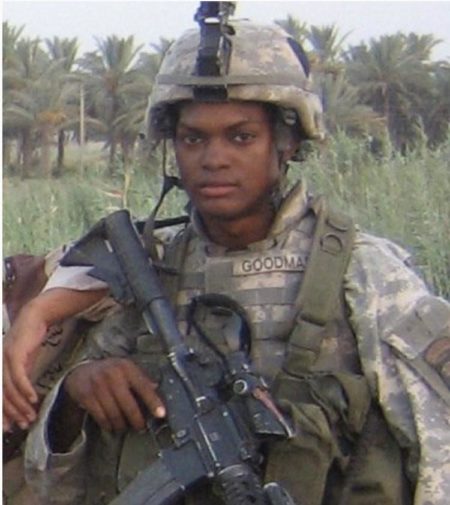
Not long after, Goodman joined the United States Army, serving from 2002 to 2006. During his time in service, he was part of the 101 st Airborne Division, serving in the Iraq War. He left the military as a Sergeant to later join US Capitol Police in 2008. His former unit XVII Airborne Corps said he was a hero long before the incident on Jan 6. He is truly a guardian of his city, from a very young age.
On Jan 6 th , 2021, our Democracy was attacked by rioters. Shock and disbelief are among some of the reactions that most people had, as everyone watched live on national television as the United States Capitol building was being breached. At the time, both the House and Senate Chambers we’re in the middle of certifying the official win of President elect Joe Biden and Vice President elect Kamala Harris.
The world watched in shock and prayed for the safety of everyone inside as the unimaginable happened at the Capitol that day. It seemed like a movie that went on for hours. All those defending our democracy that day are heroes, but after getting a closer look at personal videos, security footage and more, one hero stood out, and his name was Eugene Goodman.
As Goodman saw the rioter’s approach his location, without a doubt, he took matters into his own hands and tried to diverge the crowd in front of him away from the Senate Chamber while calling for back up in another part of the Capitol. Eugene used himself as bate, knowing that they were only feet away from the Senate Chambers where Vice President Mike Pence and over 100 other officials prepared for the worst. Eugene Goodman’s actions that day may have save their lives, and for that he was recognized worldwide, and awarded the Army’s Distinguished Public Service Award. Both Republican and Democratic politicians, have commended Goodman for single-handedly taking action and preventing a bigger tragedy than what they had already been living.
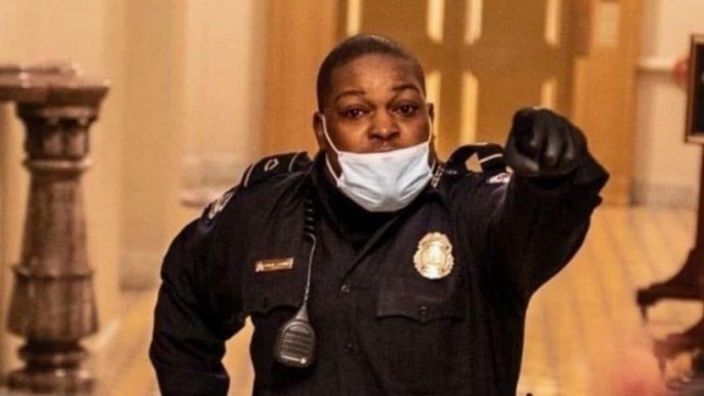
Following the incident on Jan 6 th , 2021, Eugene Goodman’s actions that day have been highly recognized worldwide, and for those actions was awarded the Army’s Distinguished Public Service Award. Lawmakers have also proposed a bill to award Capital Police Officer Eugene Goodman with the Congressional Gold Medal; one of the highest awards a civilian can receive. As grateful as he is, it is reported that he is also afraid he might be targeted by extremists and said he would do the exact same thing again. During the Presidential Inauguration, Goodman got to escort Vice President-elect Kamala Harris to the stage. He was promoted to Sergeant at Arms of the United States Senate and was announced as such during the Inauguration where he received a standing ovation.
Eugene Goodman has become a household name since that very day. His courageous actions protected not only the people inside the U.S. Capital building, but also everything it stands for, as a symbol of democracy which is the very base of our country. Eugene Goodman goes down in history not only as a great human being but as a guardian of the city of Washington D.C. The Purple Heart Foundation is proud to recognize him as an outstanding member of society for his selfless acts, not only on Jan 6th but throughout his career. Men and women like Eugene, are the ones that keep our country safe and give us the freedom we take for granted every day. So, we thank you, Eugene Goodman, for your bravery, valor, and lifetime of service to this great nation.

SOURCES:
https://en.wikipedia.org/wiki/Eugene_Goodman_(police_officer)
Vietnam Veteran to High School History
We all wonder where life will take us, he never wondered, he knew. John Harrison, a sophomore student at North Carolina University, wanted to fly helicopters but the only way he was able to, was by joining the Army. Not many would jump at the idea of joining the military, but he did… just to fly helicopters. Growing up he had a great childhood, a loving family and no regrets. With a clear vision in mind and the love for helicopters in heart, he pressed on with the hopes of making a difference.
It didn’t take long for John to get through Basic Combat Training, pass all qualifications and tests at Ft. Polk, L.A. and confidently begin his service in the United States Army, something he had aspired to do for so long. The transition from civilian to soldier was not an easy one though; it was divided into three parts…
- “The RED phase” is the beginning of your training, to prepare you for what’s to come.
- “The WHITE phase” is where he got most of the physical and psychological strength.
- “The BLUE phase” taught him how to handle weapons.
During the first several months in the military, John really enjoyed his time with fellow soldiers and instructors who only had “Tough love” for him. Since he had prepared well for the Army he was in great shape to withstand just about anything, even though he recalls the weather being too hot. It was so unbearably hot in Vietnam that they would drink 4 to 5 gallons of water, every day.
Many would be surprised how John expresses his take on joining the army, but this experience changed his life, his points of view, and his whole being. In the military you can train and prepare as much as possible, but nothing is like experiencing the challenges and traumas of combat than real life. John went to Officer Candidate School later, where he became Airborne Rifle Platoon Leader and Company Executive Officer.
Not long after, his unit was deployed to Vietnam on a USNS (United States Naval Ship). John joked, that although his accommodations on that ship weren’t great, the food was the best part. Since the ship was old, they had to stop at an island in the Philippines for repairs. While on the island, many of them stayed late in a club and almost ended up getting killed! Then after leaving the island, they came across the end tag of a typhoon and many were having trouble keeping their food down.
Finally, they reached Vietnam. They were told they would be safe because they were being protected by South Korea. One of the scariest and most unexpected moments in Vietnam was the first time he got shot at while walking in the mountains with his platoon. John thought to himself that he had been around shooting ranges so it wouldn’t be such a big deal…but as they kept taking on fire, he felt dumbfounded, he didn’t react, he didn’t really know what to do in that moment. The firefights in Vietnam were nothing like they had trained for.
John lasted 4 years in the Army, and said that it was nothing like he had expected. The military can train you so much, but you will never be completely ready to fight when it comes down to it. He was awarded the Purple Heart medal, because he was wounded during his service in Vietnam. He is thankful every day for not ever being captured as a prisoner of war (POW) and for being able to come home to his family. John retired from the military and went back to school to study Law. He became a well-known attorney and realtor in the Washington-Metropolitan Area. Later he went on to teach law at Bishop Denis J. O’Connell High School where he said he truly enjoyed his time with his students and learned a lot from their different opinions.
Now John enjoys his time traveling, being at home and just enjoying life. He has published two (2) books, in which he narrates his life experiences in Vietnam. From one’s first impression of John though, you wouldn’t think he was a veteran or picture him in the dangerous settings he described to me today. One thing is for sure though, John Harrison is and always will be, “Army Strong”.
Raising Awareness About Post Traumatic Stress
In WWI it was called Shell Shock; in WWII, Battle Fatigue. Korean War veterans were diagnosed with War Neurosis, and Vietnam vets with Post-Vietnam Syndrome. Whatever you call it, Post Traumatic Stress (PTS), as it’s now known, continues to affect hundreds of thousands of veterans.
Today is PTSD Awareness Day, a day to speak up about post-traumatic stress, a condition that’s underreported, misdiagnosed, and, so often, misunderstood.
PTS BY THE NUMBERS:
- 10-13% of combat veterans experience post-traumatic stress in their lifetimes.
- Studies estimate that 1 in 5 military personnel returning from Iraq and Afghanistan has PTS.
- PTS affects to 20% of Operation Enduring Freedom and Operation Iraqi Freedom veterans; 10% of Gulf War veterans, and 30% of Vietnam War veterans.
- 17% of combat troops are women; 71% of female military personnel develop PTS due to sexual assault within the ranks.
- The number of diagnosed cases of PTS in the military jumped 50% in the past year.
SEPARATING MYTH FROM FACT
The psychological scars of post-traumatic stress may be invisible, but its manifestations are not. Left untreated, it can lead to depression, drug and alcohol abuse, or suicide. Despite its prevalence, post-traumatic stress is often ignored, misinterpreted, and sensationalized by the media.
Listening to the stories of veteran experiencing post-traumatic stress can help us separate myth from fact.
MYTH: People begin experiencing PTS immediately after a traumatic event.
FACT: Sometimes symptoms surface months or years after a traumatic event or returning from deployment.
“ I was sober and clean almost 11 years, and I just couldn’t handle it no more, you know, my life. I couldn’t hold a job. I always had problems sleeping…very irritable, the whole bit. Plus, my family was always telling me I should go get some help.”
US Navy ((1971 – 1972))
SN, Ammunition Transporter
Vietnam
MYTH: Service members can never fully recover from PTS.
FACT: When people seek help and maintain a treatment program, post-traumatic stress symptoms can be managed or overcome entirely.
“My ability to overcome the situations that cause me to act negatively and not beneficial to me, are up to me, and I continue to seek treatment. I want to make a choice, not have my depression make the choice.”
Traumatic Brain Injury and the Importance of Connection
Often referred to as the signature injury of the Iraq and Afghanistan wars, the prevalence of traumatic brain injury (TBI) among veterans is higher than it’s ever been. The most common cause of TBI among Operation Enduring Freedom and Operation Iraqi Freedom service members is injuries suffered from Improvised Explosive Devices, or IEDs, used extensively against Coalition Forces.
Many people who sustain a Traumatic Brain Injury recover completely. However, in severe cases, a traumatic brain injury can cause emotional and behavioral changes that can be difficult to understand and accept.
A traumatic brain injury affects the entire family and often results in financial challenges, job loss and isolation. In the United States, 1.7 million people sustain a TBI each year. Whether you have suffered a TBI or are caring for someone who did, understanding you’re not alone is critical, the best thing you can do is reach out.
Join a group
Meeting in person with other people with similar experiences can be cathartic. There are several places to find groups in your area.
Meetup.com has many brain injury and veteran meet ups across the country.
The Brain Injury Association of America has local chapters and various support groups throughout the U.S.
Share your story
When you can share your story and hear the stories of others, you realize there are people out there who understand what you’re going through, who can commiserate, or help put things in perspective. Luckily, the internet makes sharing easier than ever.
Brainline Military is an organization that serves the military community providing information, resources, and support for current and former service members and their families living with traumatic brain injury. Read the personal stories of military members living with TBI, and share your own.
A quick search for “Facebook TBI support group” turns up a handful of pages where you can connect on Facebook and be part of the conversation.
Get Informed
Knowing about traumatic brain injury—the symptoms, treatment options, and benefits you’re eligible for as a veteran or active duty military—will allow you to thrive, not just survive with this condition.
Take a look at our list of TBI resources.


